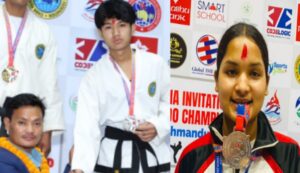
Art simply means visual art, a visual object or experience consciously created through an expression of skill or imagination. It is a sacred method of revealing truths, facts, feelings, emotions or thoughts by the medium of painting, sculpture, drawing and so on. Though a person creates it, from his/her own individual sense, it reflects the immense meaning of the contemporary society, history, culture, norms and practices in an artistic way. Therefore, in the art, reality is manifested with the color of imagination. It is neither only an imagination nor reality; it is a creation of blending imagination into reality.
The term “art” is etymologically related to the Latin word “ars” meaning art, skill or craft. It seems to come from 13th century manuscripts. However, it has probably existed since the founding of Rome. Its exact time and place has not been found from where and when it emerged but the cave painting in the Europe has been generally considered as the beginning of art. It is also mentioned that the origin of art is very old and interesting. Thousands of years ago, a man drew his own shadow. He took up a burnt stick and drew around it. He started to draw stick figures in the caves. This is how art got started. So, art is a creative skill acquired by experience, study or observation.
The main concern of the writing is particularly on the combination of reality and imagination rather than beauty. If the art is discussed or explained merely from the perspective of beauty, it will be senseless and valueless because the heart of the art is the union of reality and imagination. Reality means the fact, truth or experience what he/she gets or bears whereas imagination is the innovation of an ideas or thoughts which crafts the reality in the form of art. Suppose that a person is going to build a house with its own design. It doesn’t mean he is not making house on the earth surface, it means the structure of the house is designed distinctively because of the surface. The earth surface and design of the house can be present as a reality and imagination respectively where the construction of the house can be expounded as a skill or creation. An artist directly or indirectly links his/her imaginative concept with the reality for generating the art. As a result, reality can be called as a source of imagination conversely the creation is described as a result of imagination.
Art is a pure creation neither it has the nature of biasness nor any ambiguity. It can accomplish after the deep meditation, untiring effort and dedication. Perhaps, it is not created centralizing on the purpose of beauty as well expecting rewards and praise rather it is invented to expose reality using the color of imagination in the form of visual object. There is a great debate on the beauty of art. The famous philosopher Plato and Aristotle forwarded their view on the objective beauty which means beauty lies in the object. It is not about the experience of the observer. But then the popular philosopher David Hume and Immanuel kant claimed that beauty is subjective. It is a matter of feelings and emotions. Beauty is in the mind of the person beholding the object. From what I can gather, without touching the heart of the art, speaking only about the beauty is same like judging a person from his/her appearance. An artist intention from the art is not to display beauty instead to transfer knowledge, information, events and practices of the history in a profound manner. So, the beauty is not depending upon the object, it is the perceptions of the observer.
Art has diverse forms which are constructed with the combination of reality and imagination. In the absence of reality only the imagination will be fictional and worthless as well without imagination, reality will be tasteless. Reality enhances imagination for well creation. Reality generally means an object or situation which an artist sees and observes and innovates visual art in a constructive way. The famous person Leo Tolstoy says, “Art is the activity by which a person, having experienced an emotion, intentionally transmits it to others.” Only the person retaining proficiency and knowledge may polish the art in an imaginative way for disseminating actual evidence. Hence aesthetic experience is the inseparable part of the art. Aesthetic, in the art, is an experience of key truths. To give you an idea Newton discovered the theory of Gravitation. One day he was walking in the garden at that time he saw an apple falling from the tree and he started to think why it fell down but didn’t go up. From that reality he imagined and developed the theory. Though, he used it in a different way for another purpose but the reality is that the scene of falling apple made him to think and imagine. So, art is also the invention happening from reality and imagination.
Art is an exercise of human capacities of mind. It has diversity in its form and structure but it is particularly categorized into traditional art and modern art. Traditional art is visible in the form of painting in cave on the other hand modern art which is used for communication appears in various forms. In consequence, it is stated in the book of “Art and Imagination” that the heart of modern aesthetics: aesthetic experience to both art and nature, considered a distinctive form of knowledge, an emotional experience or an exercise of the imagination. The famous thinker Baumgarten writes that aesthetic, although it is still “the science of sensory cognition” in general, is also the theory of liberal arts, the logic of the inferior faculty of cognition, the art of thinking beautifully, the art of the analogue of reason.” Undoubtedly, art is an attractive method of carrying reason and logic. What a human sensory organ sees and observes will be displayed in the art with an intensive thinking. The thinker Hansgeorge Gadamer says, “Experience offers resources that allow the imagination to perform both its constructive and critical functions.” Thus, imagination works as a reconstruction and Experience or Reality is the engine that drives the movement of the constructive and critical roles of the imagination.
Besides, art has been carried out different purposes according to time and situation. If we evaluate it sometimes it has been constructed from religious perspective, sometimes from rulers, some from social, industrial and cultural sides too. Some sociologists highlight that hunting and gathering communities believed that art had magical properties. Art also had a religious function. This is well depicted in the paintings inside religious buildings such as Churches and temples. It is embraced by people all over the world. It allows them to communicate and express their creativity. Today, it has become much broader in comparison to the past, where it is used for political causes, psychological well-being, commercialism and social causes. Consequently, it is valuable because it can present important truths about human nature and conduct in engaging and therefore moving ways. In addition to art is very important in the society because it is an essential ingredient to empowering the hearts of people. When activists are showing images of children suffering from poverty or oppression in their campaigns, this is the art pulling the heartstrings of society’s elite and powerful to make changes. Similarly, when photographers publish the photos of war-torn areas, it attaches the attention of masses whose hearts reach out for those who need help. Therefore, art is an invaluable means of changes, source of pleasure, inspiration, information and knowledge as well a way of increasing connection and expansion and identity too.
Dhakal is a research fellow at Institute of Hermeneutics of Guangdong University of Foreign Studies, China.


